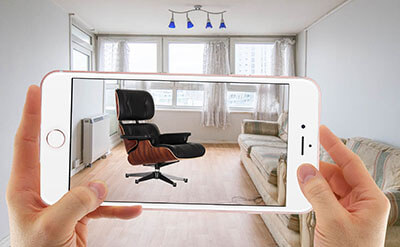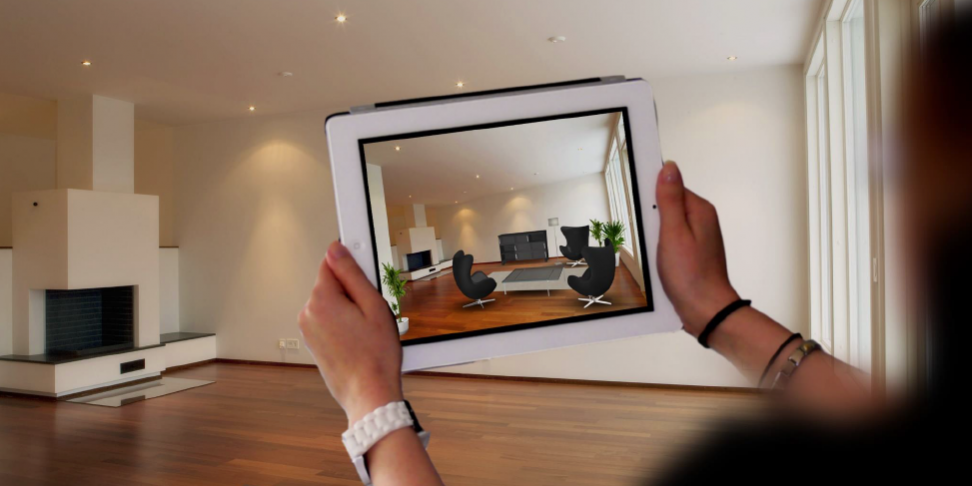Augmented reality in retail (AR) lets furniture sellers and their customers insert virtual objects like sofas and dining room sets into real-world spaces such as a person’s living or dining room. The technology offers a competitive advantage by transforming the retail experience.
Why Augmented Reality is a Valuable Sales Tool
As a sales tool, the pluses of augmented reality in retail go beyond customer interactions.
- Sales recruits can examine products and their options in virtual 3D on their personal devices without having to walk to the warehouse or sales floor for physical appraisals, which can interrupt classroom training or private study. They can find out about new product launches and increase their technical proficiency using online manuals that can be easily modified or added to for new releases.
- Rather than depending on expensive photography, marketing staff can use AR to generate photorealistic renderings of products, even placing them in virtual settings. The results can then be captured online as static two-dimensional images or 3D objects that customers can interact with so they can admire the product from all sides.
During the actual sales process, retailers can showcase furniture in virtual showrooms or in homes. In-house designers can create rooms based on a customer’s desires and fill them with potential furniture purchases that he or she intends to purchase. Trials become truly risk-free for both buyer and seller because customers can place different products in virtual home instantly to determine which piece works better in what space. When customers have settled on a choice, they can then customize it with different colors and fabrics. It becomes less likely that they will return something personalized to their exact needs. Sellers aren’t stuck with a customized return that no other buyer will want.
Advantages of Using Augmented Reality in Retail
When you use augmented reality in retail, you gain the following advantages:
- You stand at the forefront of a new technology that few other businesses are using at the moment. This reveals to customers, competitors, and vendors that you evolve with the changing times as an industry leader. Your different content and approach put you ahead of the competition.
- Because the tech is available on personal devices, sales consultants can turn a chance encounter with a potential buyer on a bus or in a supermarket into an AR product demonstration. They can even leave a sample of the tech and the virtual furniture with the customer.
- This advanced approach is particularly appealing to younger customers who enjoy AR as one of the trending technologies. As long as they have a smartphone or tablet, they can enjoy your offerings without spending additional dollars, such as on virtual reality devices.
- Many customers find AR entertaining and will want to try it out just because it is new. The novelty encourages them to engage with your advertising, browse your online site, or remain in your brick-and-mortar store, which increases the possibility of a sale. They may return for the chance to try the technology again.
- When consumers enjoy the tech, they will inform their friends and social media contacts who will be encouraged to visit your site to try it for themselves. Those visitors can evolve to become your newest customers.
- Instant personalization encourages buyers to opt for more profitable versions of your products. For example, when buyers discover that a virtual cloth-upholstered version of the armchair they want to buy looks cheap in their luxuriously decorated living room, they may try a leather that looks more appropriate. They will then order the upscale version.
- Store returns go down because customers already know in advance that their purchases will look good and function appropriately in their homes.
What Big Players Use AR in the Furniture Retail Business?
Aware of the advantages of augmented reality in retail, many big furniture retailers currently depend on the technology:
- Ikea Place, which is a mobile AR app developed by Ikea, encourages consumers to select the right products by creating design aspirations. It places virtual true-to-scale furniture pieces in customer spaces so a buyer gets a better idea of how the products fit in.
- WayFairView does the same thing for products from Wayfair’s online catalog. Pushing a convenient button transfers to the retailer’s regular purchasing app so the customer can quickly buy the piece they are viewing. This seamless integration between two apps gives consumers more confidence in the technology and retailer.
- Lowe’s has developed several apps that take advantage of AR because they “believe in harnessing the power of technology to solve everyday problems,” says Ihad Jawhar, Vice President of Digital Development at the company.Envisioned by The Mine is similar to the previous two apps in allowing virtual furniture to be set up in customer areas. Images of the setup can then be captured and shared. The app integrates with TheMine.Com, a luxury home furnishing site, for instant shopping.Holoroom relies on Oculus Rift to present a room simulation with the furniture set up in advance. Customers can then wander the room and gain some idea of how they can physically interact with the space.
How Augmented Reality Influences the Furniture Shopper
 Because of Augmented Reality, about 72 percent of customers bought products that they did not originally think of buying. Or so asserts a study that was conducted on 1,000 US consumers entitled “The Impact of Augmented Reality on Retail.”
Because of Augmented Reality, about 72 percent of customers bought products that they did not originally think of buying. Or so asserts a study that was conducted on 1,000 US consumers entitled “The Impact of Augmented Reality on Retail.”
- About 60 percent of respondents had already tried out AR for shopping. They generally found the technology to be helpful, fun, and unusual with many saying it saved them time.
- They enjoyed the experience enough that nearly 68 percent said they would engage more with retailers offering AR.
- Nearly 40 percent were prepared to buy more expensive items.
Because of the different problem associated with furniture purchases, nearly 60 percent of customers preferred to shop for that using AR, according to another study by Centric Digital LLC. Issues such as not knowing the scale of the piece or how it would fit into their decorating schemes disappear with AR.
If you’re interested in finding out how Augmented Reality in retail affects you, please contact us. We will be pleased to demonstrate how the technology can integrate with your marketing program.






294 Comments